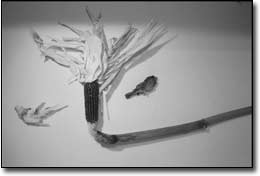A chat with Durango artist Mike Brieger
by Jules Masterjohn
 |
| Artist Mike Brieger’s "The birds that come
from smoke" on display at the Durango Arts Center/Photo
by Todd Newcomer. |
 |
| A collection of caricatures drawn together become "Wrapping
paper prototypes."/Photo by Todd Newcomer. |
It is a privilege to get a glimpse into the psyche of an artist. For anyone willing to ascend the stairs to the second floor of the Durango Arts Center, an enigmatic experience awaits. Durango artist Mike Brieger has "decorated the room" with his creative musings. This artist's mind is a place of uncomplicated poetic sculptural forms, of bizarre figurative explorations in pencil, and of raw and direct impulses set in paint. The unifying force shared by all the pieces in this exhibit is an economy of spirit. This body of work is rich in concept and suggests playful and mysterious energies at work within a sparseness of physical form - Brieger succeeds at conveying more with less.
The first example of this artist's pension to reduce his expressions to their basic elements is seen in what he calls his "Thanksgiving ensemble," an arrangement of found objects on the room's north wall. One of the two components in this grouping is "Beaver from burrs," a 2-foot long beaver form, covered with burrs from snout to tail. Straddling either end of the beaver are two of Brieger's childhood drawings depicting the Pilgrims. On the wall above the beaver hangs a construction, "The birds that come from smoke," which suggests a large ceremonial pipe. Fabricated out of an indigo blue corncob and a corn stalk, this 5-foot long peace pipe has two small stuffed songbirds wafting alongside, hovering like smoke. A visual haiku, I find this a most intriguing piece to contemplate. Curious, I asked Brieger about the ensemble.
JM:
Why burrs and beavers? Is there any logic intended with this combination?
MB:
No, but it goes with the Thanksgiving theme, kind of the early American idea of this piece. The beaver is an American symbol, it was gold on the frontier. Beaver pelts were worth dough and a lot of things happened over pelts. The fact that it's made out of burrs is just the joy of having burrs growing in the neighborhood.
JM:
Is the presence of the pipe a symbol of unity between the early settlers and American Indians?
MB:
I think that generally the peace pipe is seen in a romantic way, like passing it around in a ceremony. It's been one of my symbols and was an ad lib, as it were, to put the pipe in this piece I was just dropping some Thanksgiving clues. Really, it's just what came out in the process.
 |
| A variety of rusted cans becomes "The beauty in
the mundane collection." / Photo by Todd Newcomer. |
JM:
Another piece that utilizes found objects, "The beauty in the mundane collection," consists of an ordered assortment of squashed cans, smashed soft drink cups, abraded matchbooks and rusty metal bits presented on two long shelves on a wall. You refers to this austere linear arrangement as a "sentence."
What can you tell me about this piece?
MB:
I just collected these circles (can ends) because they are beautiful circles, but when I put them in a line I started thinking that this piece is a metaphor for me like I was born completely, perfectly round but with a lot of karmic dents and dings. Over time, I got kind of flattened, beaten and torn and healed over and flattened more, and ended up much smaller and a little rounded over so I like that.
Brieger includes an interactive piece, "Try them Try them You will see," consisting of two pairs of goggles made out of inner tubes and brake light lenses. If you have ever wondered what the world looks like to a brake light, try them and you will see.
Also on display are three drawings, "Wrapping paper prototypes," large sheets lined with rows of sketched faces each with unique facial characteristics and expressions as well as and a pair of 10-foot tall drawings titled, "Weeping weeping."
Though he makes sculptures and drawings, Brieger considers himself a painter, first and foremost. In a shallow display box sits a stack of paintings on paper. Most of the paintings have an aged and smoky surface quality that he achieves by using oil glazes over monochromatic acrylic colors. Visually and emotionally dark, the content of these pieces is reinforced through titles like "The explaining in the kitchen" and "The artist's mother and her dumb fur coat."
JM:
Your work is eclectic in form and content. Do you work with a lot of ideas?
MB:
For the first 15 years or so, yeah, I always used to have multiple ideas. But not anymore. Now when I paint, I just paint I don't have to waste time with inspiration. It's a rough road to paint. People say drawing is the basis of all art but I think painting is king.
JM:
Are there painters whose work arouses your creativity?
MB:
There are lots of artists whose work I dig, like Georges Rouault, the French painter. Years ago, my wife and I had a tiny little black and white TV, the pop-up kind with a screen 4 inches big. One day a movie was on that was set in a Hollywood producerhouse and on his wall was a portrait of a woman by Rouault. On the small screen, the portrait itself must have been no bigger that a 37-cent stamp and it was like "OH YEAH!" That was a classic inspirational thing for me and I was up in my studio painting like a freak the whole next day."
Mike Brieger's work can be seen in the Art Library upstairs at the Durango Arts Center through December and is represented by the Mark Woolley Gallery in Portland, Ore.
☯
|